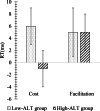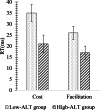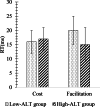Visuospatial cueing differences as a function of autistic traits
- PMID: 38561567
- PMCID: PMC11093807
- DOI: 10.3758/s13414-024-02871-0
Visuospatial cueing differences as a function of autistic traits
Abstract
Atypical orienting of visuospatial attention in autistic individuals or individuals with a high level of autistic-like traits (ALTs) has been well documented and viewed as a core feature underlying the development of autism. However, there has been limited testing of three alternative theoretical positions advanced to explain atypical orienting - difficulty in disengagement, cue indifference, and delay in orienting. Moreover, research commonly has not separated facilitation (reaction time difference between neutral and valid cues) and cost effects (reaction time difference between invalid and neutral cues) in orienting tasks. We addressed these limitations in two experiments that compared groups selected for Low- and High-ALT levels on exogenous and endogenous versions of the Posner cueing paradigm. Experiment 1 showed that High-ALT participants exhibited a significantly reduced cost effect compared to Low-ALT participants in the endogenous cueing task, although the overall orienting effect remained small. In Experiment 2, we increased task difficulty of the endogenous task to augment cueing effects. Results were comparable to Experiment 1 regarding the finding of a reduced cost effect for High-ALT participants on the endogenous cueing task and additionally demonstrated a reduced facilitation effect in High-ALT participants on the same task. No ALT group differences were observed on an exogenous cueing task included in Experiment 2. These findings suggest atypical orienting in High-ALT individuals may be attributable to general cue indifference, which implicates differences in top-down attentional processes between Low- and High-ALT individuals. We discuss how indifference to endogenous cues may contribute to social cognitive differences in autism.
Keywords: Attention; Cognitive and attentional control; Cognitive neuroscience.
© 2024. The Author(s).
Conflict of interest statement
The authors have no known conflicts of interest to disclose.
Figures









Similar articles
-
Quicker Exogenous Orienting and Slower Endogenous Orienting in Autistic People.J Autism Dev Disord. 2025 Apr;55(4):1495-1509. doi: 10.1007/s10803-024-06311-8. Epub 2024 Mar 6. J Autism Dev Disord. 2025. PMID: 38446266 Free PMC article.
-
Social and non-social cueing of visuospatial attention in autism and typical development.J Autism Dev Disord. 2011 Jun;41(6):715-31. doi: 10.1007/s10803-010-1090-z. J Autism Dev Disord. 2011. PMID: 20809377 Free PMC article.
-
Spatial orienting around the fovea: exogenous and endogenous cueing effects.Cogn Process. 2015 Sep;16 Suppl 1:137-41. doi: 10.1007/s10339-015-0688-7. Cogn Process. 2015. PMID: 26232192
-
Unconscious attentional orienting to exogenous cues: A review of the literature.Acta Psychol (Amst). 2010 Jul;134(3):299-309. doi: 10.1016/j.actpsy.2010.03.002. Epub 2010 Apr 8. Acta Psychol (Amst). 2010. PMID: 20378092 Review.
-
Sensitivity to eye gaze in autism: is it normal? Is it automatic? Is it social?Dev Psychopathol. 2008 Winter;20(1):79-97. doi: 10.1017/S0954579408000047. Dev Psychopathol. 2008. PMID: 18211729 Review.
References
-
- American Psychiatric Association. (2013). Neurodevelopmental disorders. In Diagnostic and statistical manual of mental disorders (5th ed.).10.1176/appi.books.9780890425596.744053
MeSH terms
Grants and funding
LinkOut - more resources
Full Text Sources

